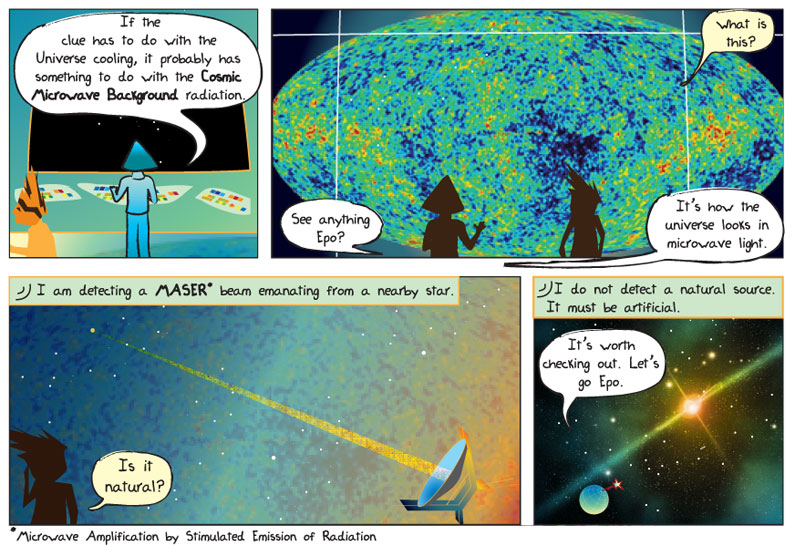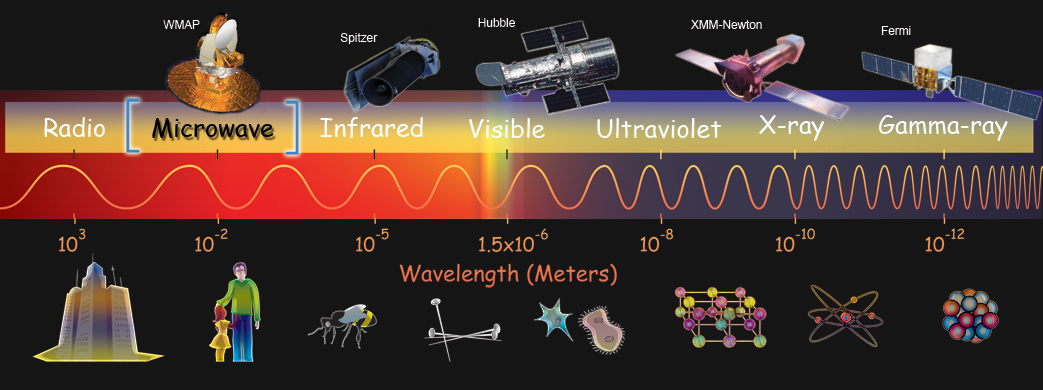
Transcript
Panel 1
Alkina: If the clue has to do with the universe cooling, it probably has something to do with Cosmic Microwave Background radiation.
Panel 2
Alkina: See anything, Epo?
Beggrin: What is this?
Alkina: It’s how the universe looks in microwave light.
Panel 3
Epo: I am detecting a MASER beam emanating from a nearby star.
Beggrin: Is it natural?
Panel 4
Epo: I do not detect a natural source. It must be artificial.
Alkina: It’s worth checking out. Let’s go, Epo!
What does it mean?
Cosmic Microwave Background (CMB) – This is the radiation left over from the big bang. It was produced early in the age of the universe, when the average density and temperature were much higher than today. The expansion of the universe has cooled the radiation to its current temperature of about 2.7 kelvin (The SI unit of temperature is the kelvin, symbol K. The name is to honor the 19th Century Scottish physicist William Thomson, who is more commonly known as Lord Kelvin).
MASER – Stands for Microwave Amplification by Stimulated Emission of Radiation. It’s like a laser, but in microwave light instead of higher energy optical light.
In human speak please!
The Cosmic Microwave Background is some of the strongest evidence for the Big Bang Theory. That theory predicts that our universe began in a very hot and dense state, and that it subsequently expanded, eventually becoming the cool, low density universe we see today. However, that hot dense time should have left an imprint on the universe, even to the present day.
If we use visible light detectors to look at regions of space that do not contain stars or galaxies, we won’t see much. However, if we look at these same regions using microwaves, we see a faint glow. In fact, this glow is seen coming from all directions, sort of the way a blue glow is seen in all parts of the sky on a cloudless afternoon. The spectrum of the microwave glow is precisely that of Planck radiation (the Sun and other stars also have a Planck spectrum), and the temperature of the microwave spectrum is 2.7 kelvin (2.7K). The spectral shape of the microwave glow, a Planck spectrum, and its low temperature are extremely interesting. It turns out that the existence of background radiation, with a Planck spectrum and a temperature of a few kelvin, is a strong prediction of the Big Bang Theory. The faint microwave glow is called the cosmic microwave background, in recognition of its origins in the hot, dense early universe.

Is that all?
Cosmic Background Explorer – Mission page for the first cosmic microwave background (CMB) explorer, COBE.
The second CMB explorer – Mission page for Wilkinson Microwave Anisotropy Probe (WMAP).
Origin of the MASER – Invention of the MASER by Nobel-prize winning physicist Charles Townes.
